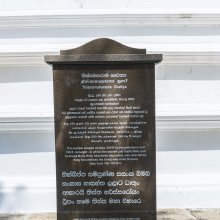Vam, Vaṃ: 10 definitions
Introduction:
Vam means something in Hinduism, Sanskrit, Hindi. If you want to know the exact meaning, history, etymology or English translation of this term then check out the descriptions on this page. Add your comment or reference to a book if you want to contribute to this summary article.
Images (photo gallery)
In Hinduism
General definition (in Hinduism)
Source: Wisdom Library: Hinduism“Vaṃ” is the bīja-mantra for varuṇa, or “water”.
Languages of India and abroad
Sanskrit dictionary
Source: Cologne Digital Sanskrit Dictionaries: Shabda-Sagara Sanskrit-English DictionaryVam (वम्).—[(ṭu, u)ṭuvamu] r. 1st cl. (vamati) To vomit, to eject from the mouth.
Source: Cologne Digital Sanskrit Dictionaries: Benfey Sanskrit-English DictionaryVam (वम्).—i. 1, [Parasmaipada.] 1. To vomit, [Mānavadharmaśāstra] 4, 121. 2. To spit out, [Rāmāyaṇa] 1, 28, 26. 3. To send forth, [Uttara Rāmacarita, 2. ed. Calc., 1862.] 148, 8. Ptcple. of the pf. pass. vānta. 1. Vomited. 2. Effused, [Meghadūta, (ed. Gildemeister.)] 20. 3. One who has vomited, [Mānavadharmaśāstra] 5, 144. Comp. Durvānta, i. e. dus-, adj. one who has been wrongly treated with emetics, [Suśruta] 2, 191, 15. [Causal.] vāmaya; ptcple. of the pf. pass. vamita, Made to vomit.
— With the prep. ud ud, To spit out, to vomit, Mahābhārata 3, 15729; figuratively, 3, 1931.
— Cf. [Latin] vomere; [Gothic.] vamm, macula, ana-vammjan; [Anglo-Saxon.] wemman, maculare.
Source: Cologne Digital Sanskrit Dictionaries: Cappeller Sanskrit-English DictionaryVam (वम्).—vamiti & vamati [participle] vānta (q.v.) vomit, spit out, give forth (vacas repent). [Causative] vāmayati & vamayati cause to vomit.
--- OR ---
Vām (वाम्).—([enclitic]) [accusative] [dative] [genetive] [dual] of 2^nd [person or personal] [pronoun]
Source: Cologne Digital Sanskrit Dictionaries: Monier-Williams Sanskrit-English Dictionary1) Vam (वम्):—[class] 1. [Parasmaipada] ([Dhātupāṭha xx, 19]) vamati ([Vedic or Veda] also vamiti [imperfect tense] avamat or avamīt; [perfect tense] vavāma vemuḥ, [Mahābhārata] etc.; vavamuḥ, [Pāṇini 6-4, 126]; 2. sg. vemitha or vavamitha, [ib.; Siddhānta-kaumudī]; 3. sg. uvāma, [Śatapatha-brāhmaṇa]; [Aorist] avān, [Śāṅkhāyana-brāhmaṇa]; [future] vamitā, vamiṣyati [grammar]; [infinitive mood] vamitum, [ib.]; [indeclinable participle] vamitvā, [Manu-smṛti iv, 121]; vāntvā, [Vopadeva]),
—to vomit, spit out, eject ([literally] and [figuratively]), emit, send forth, give out, [Ṛg-veda] etc. etc.;
—to reject id est. repent (a word), [Ṛg-veda x, 108, 8] :—[Passive voice] vamyate ([Aorist] avāmi [grammar]), to be vomited etc.:—[Causal] vāmayati, vamayati (cf. [Dhātupāṭha xix, 68]; [Aorist] avīvamat [grammar]),
—to cause to vomit, [Suśruta] :—[Desiderative] vivamiṣati [grammar]:—[Intensive] vaṃvamyate, vaṃvanti[ib.]
2) cf. [Greek] ἐμέω for ϝεμέω; [Latin] vomere; [Lithuanian] vémti.
3) Vām (वाम्):—(encl.) [accusative] [dative case] [genitive case] [dual number] of 2nd [person] [pronoun] (cf. [Pāṇini 8-1, 20; 24 etc.]), [Ṛg-veda] etc. etc. (the accented vām in [Ṛg-veda vi, 55, 1] is thought to be = āvām [nominative case] [dual number] of 1st [person] [pronoun])
Source: Cologne Digital Sanskrit Dictionaries: Yates Sanskrit-English DictionaryVam (वम्):—[(ṭu-u) vamati] 1. a. To vomit.
Source: DDSA: Paia-sadda-mahannavo; a comprehensive Prakrit Hindi dictionary (S)Vam (वम्) in the Sanskrit language is related to the Prakrit word: Vama.
[Sanskrit to German]
Sanskrit, also spelled संस्कृतम् (saṃskṛtam), is an ancient language of India commonly seen as the grandmother of the Indo-European language family (even English!). Closely allied with Prakrit and Pali, Sanskrit is more exhaustive in both grammar and terms and has the most extensive collection of literature in the world, greatly surpassing its sister-languages Greek and Latin.
Hindi dictionary
Source: DDSA: A practical Hindi-English dictionaryVam in Hindi refers in English to:—(a) left, sinistral; reverse, contrary; adverse, perverse; vile, base; ~[ta] perversity; leftism, sinistrality; —[pashrva] left flank; sinistral; —[pashrvata] sinistrality; ~[parshvika] sinistral; ~[marga] the Tantrik cult (which prescribes wine, woman, etc. as essentials); ~[margi] a follower of ~[marga] pertaining to the ~[marga]..—vam (वाम) is alternatively transliterated as Vāma.
...
Nepali dictionary
Source: unoes: Nepali-English DictionaryVam is another spelling for वाम [vāma].—adj. 1. left; 2. being or situated on the left side; 3. reverse; contrary; opposite; adverse; unfavorable; 4. perverse; crook-natured; refractory; 5. vile; wicked; base; low; bad; 6. lovely; beautiful; charming; appealing; mind-blowing;
Nepali is the primary language of the Nepalese people counting almost 20 million native speakers. The country of Nepal is situated in the Himalaya mountain range to the north of India.
See also (Relevant definitions)
Starts with (+18): Vama, Vamabhadra, Vamabhaj, Vamabhashin, Vamabhrit, Vamabhru, Vamacakra, Vamacara, Vamacuda, Vamacula, Vamadatta, Vamadeva, Vamadevi, Vamadevya, Vamadhvaja, Vamadrish, Vamadrishti, Vamagama, Vamagranthi, Vamahasta.
Query error!
Full-text (+601): Vankara, Paravam, Vamathu, Apatava, Anarjava, Asyavamiya, Udvam, Akshiva, Vami, Vanti, Adhruva, Vama, Adhvaryava, Adhidaiva, Vamati, Adhobhava, Tantava, Pratinava, Aikshava, Vastava.
Relevant text
Search found 93 books and stories containing Vam, Vaṃ, Vām; (plurals include: Vams, Vaṃs, Vāms). You can also click to the full overview containing English textual excerpts. Below are direct links for the most relevant articles:
Rig Veda (translation and commentary) (by H. H. Wilson)
Yogashikha Upanishad (critical study) (by Sujatarani Giri)
Part 2.1b - Svādhiṣṭhāna cakra (The spleen cakra) < [Chapter 5 - Nature of Yoga practice in Upaniṣad]
Part 2.1a - Mūlādhāra cakra (root or basic centre) < [Chapter 5 - Nature of Yoga practice in Upaniṣad]
Notices of Sanskrit Manuscripts (by Rajendralala Mitra)
Devala-smriti (critical study) (by Mukund Lalji Wadekar)
Guhyagarbha Tantra (with Commentary) (by Gyurme Dorje)
Text 20.5 (Commentary) < [Chapter 20 (Text And Commentary)]
Text 20.7 (Commentary) < [Chapter 20 (Text And Commentary)]
Text 7.9 (Commentary) < [Chapter 7 (text and commentary)]
World Journal of Pharmaceutical Research
VAM association in Jabalpur region mountain flora < [2014: Volume 3, October issue 8]
An ayurvedic management of varicose veins induced stasis eczema - case study < [2022: Volume 11, June issue 7]
An ayurvedic approch in the management of katigat vaat (low back pain) < [2023: Volume 12, November issue 19]


